Famiglia : Fagaceae

Text © Prof. Paolo Grossoni

English translation by Mario Beltramini
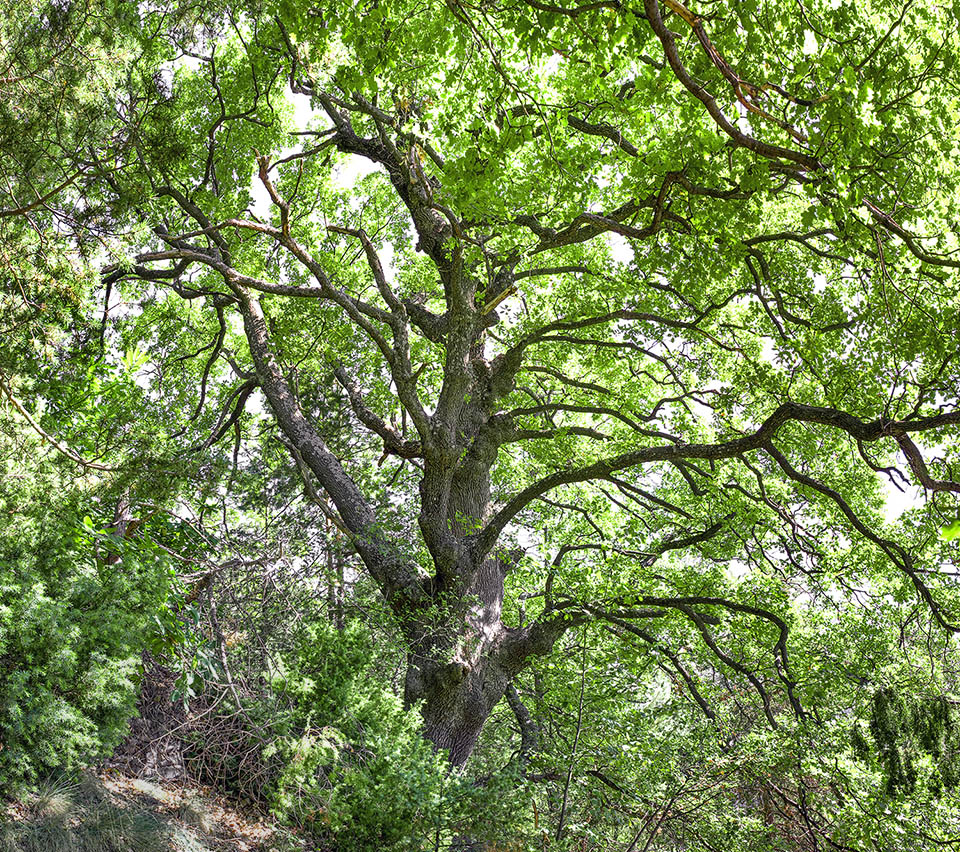
Majestic downy oak (Quercus pubescens) in a Mediterranean woodland. It is a heliophilous species and the upper part of the crown is denser © Giuseppe Mazza
Quercus pubescens Willd., roverella in Italian, chêne pubescent and chêne blanc in French, downy oak and pubescent oak in English, Flaumeiche in German and roble pubescente in Spanish, where this oak is still indicated as Quercus humilis Mill., belongs to the “European white oaks” (sect. Quercus of the subgenus Quercus) together with sessile oak (Quercus petraea (Matt.) Liebl.), English oak (Quercus robur L.), Hungarian oak (Quercus frainetto Ten.) and Pyrenean oak (Quercus pyrenaica Willd.).
The epithet ‘pubescens’ is a Latin term to highlight the dense pubescence that characterizes not only during the period of the sprouting but throughout the year the leaves and buds and even in the second year the twigs. Also Quercus lanuginosa Lam., once its most used synonym (but presently considered an illegitimate name), emphasized this character.
Compared to sessile oak and English oak, the downy oak is a slightly less tall tree, it may reach 25 m, but it is equally massive reaching 200-250 cm in diameter. It is a long-lived species and trees are known that have reached, and probably exceeded, the thousand years; often its trunk is not straight and ramifies fairly soon in large, rather sinuous, branches.
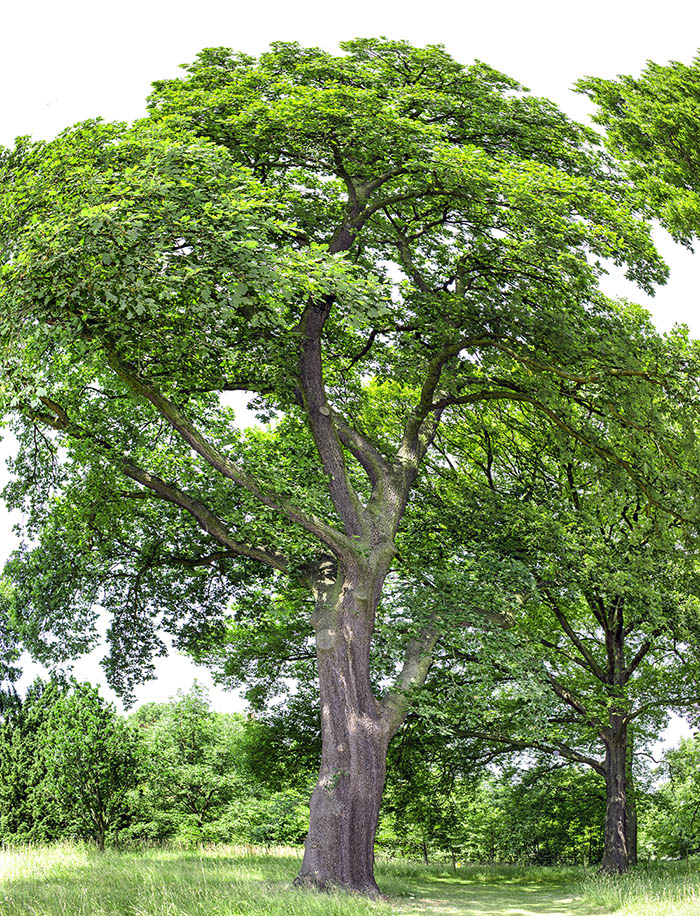
Isolated tree. Compared to the sessile oak and the English oak, downy oak is a slightly less tall tree that may reach 25m, but no less massive with 200-250 cm in diameter. It’s a long-lived species and are known trees about thousand years old © Giuseppe Mazza
In adult plants the bark is engraved by longitudinal and transversal furrows that define very hard scales, with a trapezoidal profile, elongated and wider than long.
The new twig is initially whitish and then greyish due to the pubescence that covers it and that, as aforementioned, also remains in the second year (unlike those of English and sessile which are totally hairless); the buds are large (up to 9-12 (15) mm), ovoid-pointed, grey and pubescent especially along the margins of the scales.
The leaves are alternate, simple, from ovate to obovate and even very broad in the central part, briefly cuneate or cordate at the base, (3) 5-10 cm long, with 5-6 pairs of lobes more or less obtuse at the apex and entire or usually sublobed.
The leaf blade is green, initially covered by a dense white down but throughout the year the upper surface becomes glabrescent or even slightly pubescent whilst the lower one remains light green or greyish to whitish due to the dense pubescence that is formed by long stellate hairs that can be even 300-350 μm long; the lower surface of the leaf of the sessile oak has instead a slight pubescence along the main veins whilst that of English oak is totally glabrous. The petiole is 5-15 (25) mm long and is tomentose. One of its common names in the French language is «chêne blanc», rightly in reference to the initial colour of the twig.
The wide range of the sizes of the leaf blade and the petiole and the variability of the pubescence density are due to the plurality of the forms detectable in downy oak plants. Also the acorns and their peduncles can vary considerably their sizes. Throughout the season the blade becomes leathery and reduces the pubescence without ever becoming glabrous; the abscission occurs tardily and in young plants and in juvenile branches the leaves, though drying up, do not fall until spring; for this reason they are called ‘marcescent leaves’. On the seedlings the leaves remain green throughout the whole winter.
Downy oak wood has a macroscopically very similar appearance to those of Quercus petraea and of Quercus robur because it too is a ring-porous wood with yellowish sapwood and brown heartwood and the latter is hard and deteriorates very slowly, but, compared to those of the other two oaks is much heavier; however, it has less straight fibers which make it difficult to work and, while it is drying, shrinks more. The root system, very robust and well developed in the secondary roots, retains the taproot active throughout all the life of the tree.
Compared to the other European deciduous oaks, the downy oak reaches the sexual maturity earlier (around the 10-12 years).
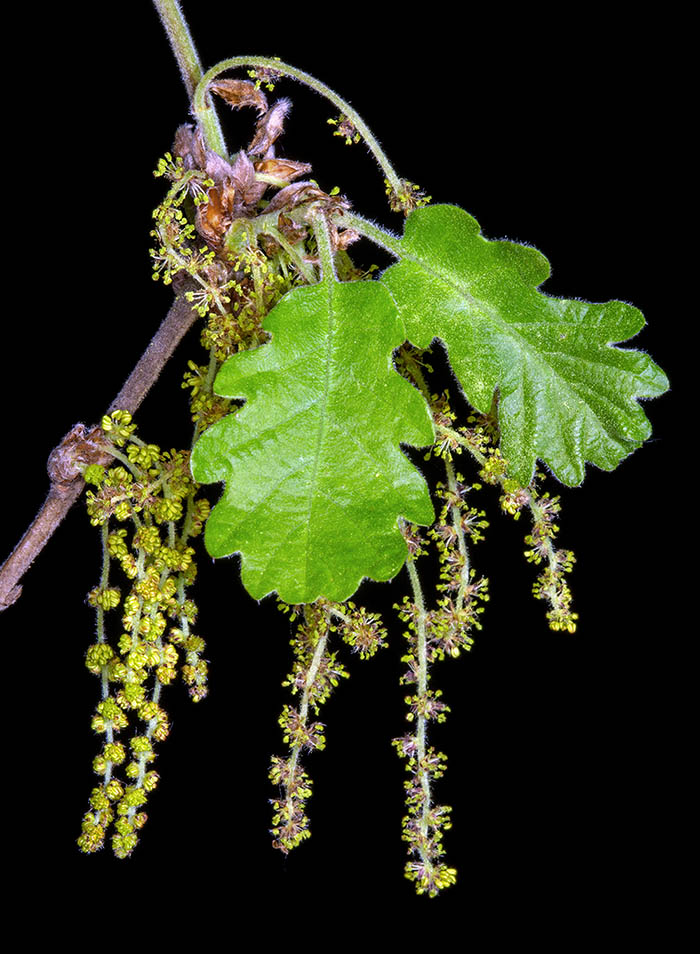
Compared to the other European deciduous oaks, downy oak reaches the sexual maturity earlier, around the 10-12 years. Since the anthesis occurs in April-May, this oak is the latest of the most important deciduous oaks of the Mediterranean area © Giuseppe Mazza
The anthesis occurs in April-May, and it is one of the last among the most important deciduous oaks of the Mediterranean region.
Like the other oaks, the downy oak is a monoecious species and its flowers are similar in the appearance to those of the other species of the sect. Quercus.
The male flowers have (6) 8 (10) stamens and are sparsely arranged on densely pubescent catkins, 5-8 cm long and inserted in the basal part of the twig of the current year whilst the female ones, with three greenish stigmas, are single or united in short spikes at the axil of the leaves of the distal part of the year twig.
The pollination is anemophilous.
The acorns, often gathered in small groups even of 3-4, have a short and pubescent peduncle; they ripe in the autumn of the same year and they are more or less ovoid or tapered, (15) 25-30 mm long and rather broad (15-20 mm); when fresh they have dark streaked integuments; the cupule may include the acorn even up to half of its length and is covered by triangular, very pubescent and greyish, scales, even approached to the apex and exceeding the hedge of the cupule. The acorn is not dormant and must germinate very quickly in order to survive; like the other species of oaks, also in Quercus pubescens the germination is hypogeal and the young leaflets, pinkish to whitish, are densely pubescent.
The range of the downy oak extends mainly in the Mediterranean basin: the central core is in the cisalpine regions (central-southern France, Italian peninsula and the large islands of central and western Mediterranean), where this oak is quite common; from it branch off a western extension, which from the Pyrenees expands to the Basque territory, a northern one which goes up from France to Belgium (not particularly numerous and only on calcareous soils) and finally a third very long extension that is spreading from the Balkan peninsula up to the Black Sea and, through the Anatolian peninsula, it reaches the Caucasus, in woodlands where it is present even if not predominant.
In these regions the downy oak is frequent, often dominant, in the woods between 200 and 800 m asl, being able to reach 1,200-1,300 m in the less cold and less humid areas.
Due to its needs in direct sunlight, when the downy oak is dominant, between tree and tree usually there are enough space that allow the development of even dense bush.
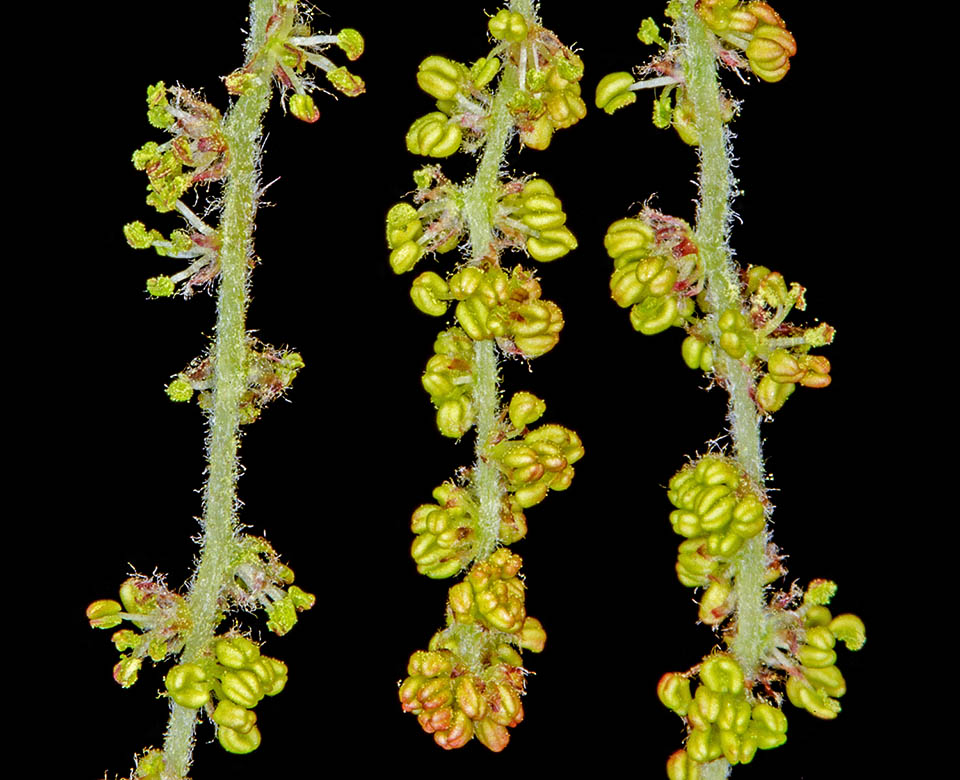
The male flowers are sparsely arranged on densely pubescent filaments (catkins), 5-8 cm long and inserted in the basal part of the year twig © Giuseppe Mazza
These woodlands are mostly xerothermic phytocoenoses of heliophilous broad-leaved trees accompanied by a cortege of other species, among which manna ash (Fraxinus ornus L.) and, in the western side, European hop-hornbeam (Ostrya carpinifolia Scop.) replaced in the Balkans and in Anatolia by several species of Celtis (Celtis australis L., Celtis glabrata Steven ex Planch. and Celtis tournefortii Lam.); especially in the Mediterranean islands and Anatolian regions become more numerous the evergreen species.
At higher altitudes there are more mesophilic species among which Turkey oak (Quercus cerris L.), sessile oak (Quercus petraea (Matt.) Liebl.), chestnut (Castanea sativa Mill.), some maples and several woody species of the Rosaceae family.
From what has just been anticipated, it is already evident that Quercus pubescens behaves as a heliophilous and relatively xerothermophilous species; it is not demanding on the quality of the soil adapting well also to calcareous ones, arid, rocky or not very rich. Towards the upper latitudinal and altitudinal limits (where the coldest temperatures are recorded), the downy oak thrives only on calcareous soils because they are less humid and warmer than those of siliceous origin. It has a very pronounced dormancy and consequently sprouts late (between April and May) usually avoiding the late frosts.
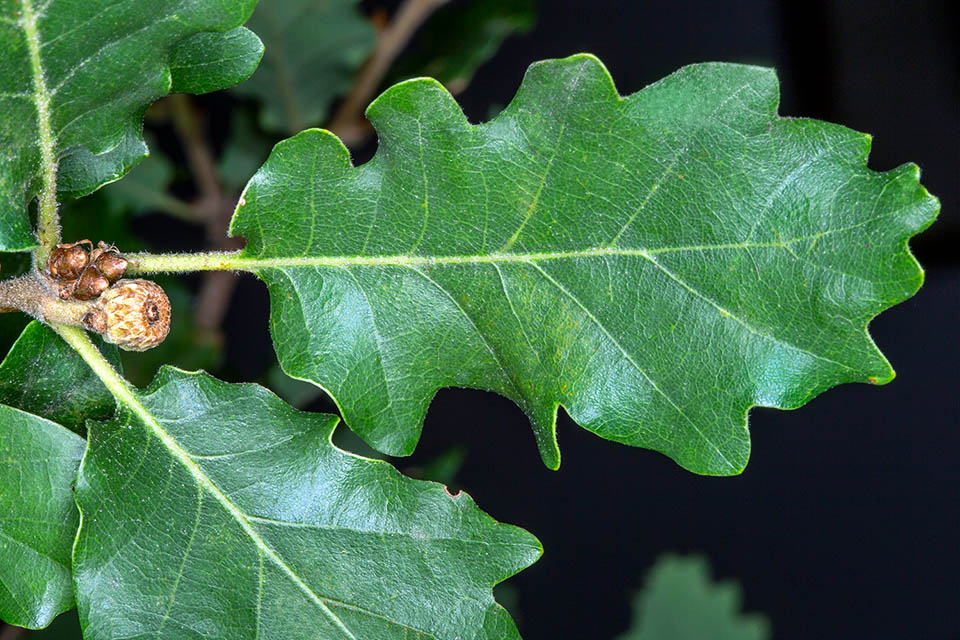
A young acorn is growing at the axil of a leaf with some buds. The leaves are alternate, simple, ovate-elongated to very wide in the central part © Giuseppe Mazza
The most important diseases that may attack the downy oak are the same that afflict the other European deciduous oaks. They range from powdery mildew (Erysiphe alphitoides), that affects the leaves especially in the cold and humid springs, to wood decay and root rot, caused mainly by several fungi, such as Daedalea quercina, Armillaria mellea, Inonotus dryadeus, Ganoderma sp.pl., Fomitiporia sp.pl., etc., that undermine the stability of the plants themselves, and to the ‘charcoal-black canker’ from Biscogniauxia mediterranea. Recently, several reports of very serious damages, attributed to Phytophthora ramorum, the primary agent of the syndromes called SOD («sudden oak death») and COD («oak decay»), have given rise to considerable concern .
There are different insects that may cause serious damages especially to adult plants; among these the most dangerous are those whose larvae (caterpillars), such as Thaumetopoea processionea and Lymantria dispar, feed on the young leaves, and those with xylophagous larvae, such as several cerambycids. The live tissues of leaves, young shoots and reproductive organs are frequently utilized by ‘gall wasps’ (Cinipidae) for laying eggs and in these instances, like the other oaks, the downy oak reacts to this ‘stimulation’ developing galls that have shape and colour determined by the species of the parasite.
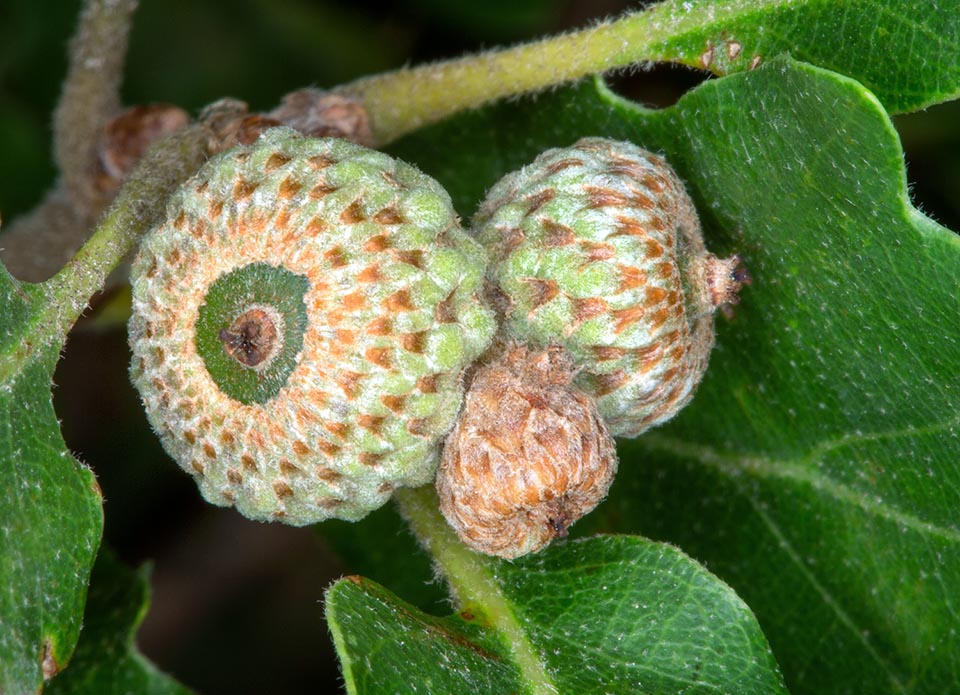
Young developing acorns. Note the hairiness still present on the upper surface of the leaves that falls later in the year © Giuseppe Mazza
Usually the damages caused by these last insects are localized and hardly can cause serious deterioration.
The oak wood is not particularly appreciated both because the trunk is not straight and because it is qualitatively inferior to those of most other oaks; it is therefore used only for some boat-building, for carpentry, packaging, agricultural tools, railway sleepers and, especially that from coppice woods, because it is excellent as firewood and as charcoal.
The downy oak high forests are employed for livestock farming (production of acorns and pasture).
Among the truffle-producing plants the downy oak is one of the most appreciated and sought. Often isolated trees or in small groups are still employed in the countryside for the delimitation of property boundaries or to signal a crossroad or the presence of isolated houses.
The latter often have some downy oaks nearby not only to shade and feed the animals but also for attracting lightning, thus saving the buildings.
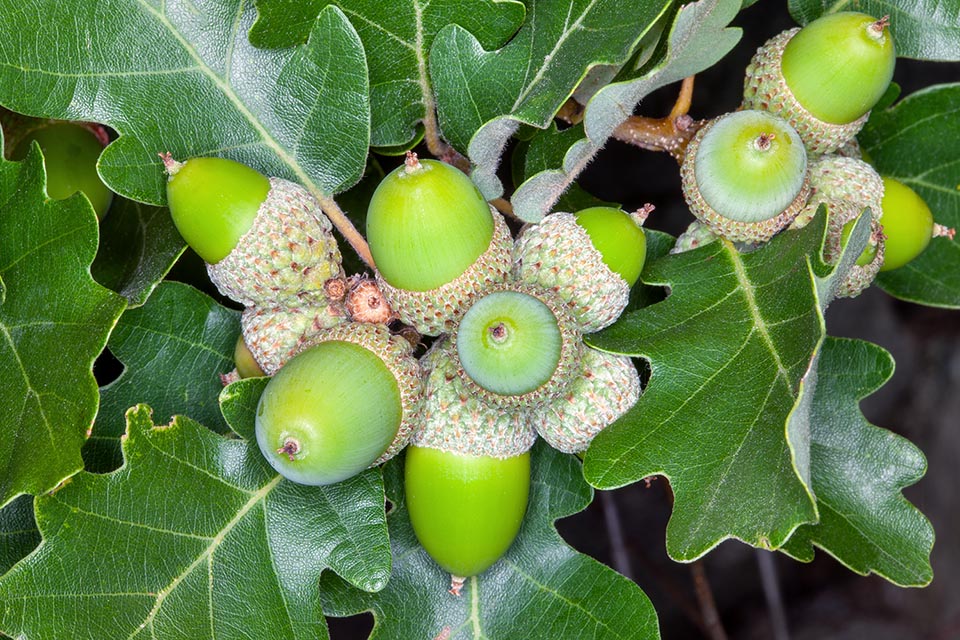
The acorns, here still covered by wax bloom, are often borne in small groups of even 3-4 and have a short and pubescent peduncle © Giuseppe Mazza
For ornamental greenery, due to its thermophily and its relative slowness in longitudinal growth, beyond the Alps Quercus pubescens is not a widely employed species preferring English oak, common oak and Hungarian oak (Quercus frainetto) and for this reason the downy oak is not frequently mentioned in texts to guide the choice of trees.
According to Flora Europaea (1993) Quercus pubescens is divided in three subspecies:
. Quercus pubescens subsp. pubescens, wich is present throughout the range with the exception of the Pyrenees and the Spanish territories;
. Quercus pubescens subsp. subpyrenaica (Villar) Rivas Mart. & C.Saenz, endemic to the Pyrenees and north-western Spain;
. Quercus pubescens subsp. anatolica O.Schwarz (= subsp. crispata Greuter & Burdet), widespread in the eastern part of the Balkan peninsula, in Crimea and in Anatolia. Its twigs turn glabrous towards the end of the first year.
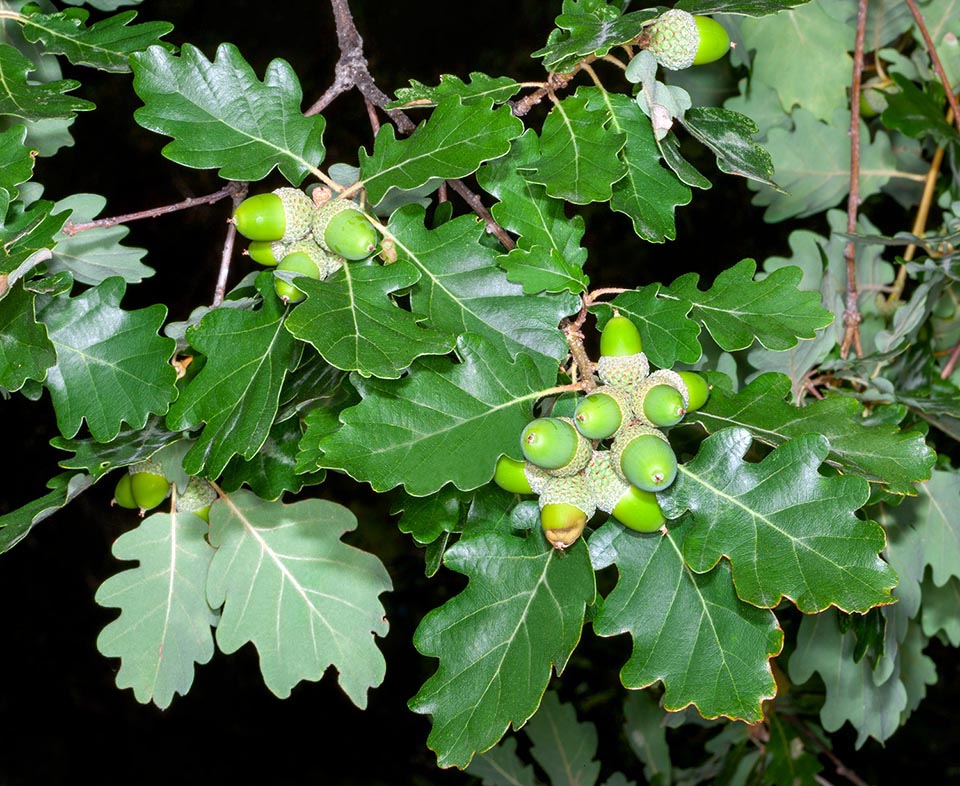
Acorns ripen in the autumn of the same year. They are not dormant and must germinate at once for surviving. Note the lower surface of the leaves densely pubescent © Giuseppe Mazza
Quercus pubescens is known and studied for its foliar polymorphism which has allowed, often too hastily, the identification of different new species resulting in subsequent successive discussions about the validity of these taxonomic typifications.
Taxa considered closely related to the downy oak, and for this reason often transferred in this species, are Quercus brachyphylla Kotschy (south-western Greece and island of Crete), Quercus congesta C.Presl (Sardinia, Sicily and southern France), Quercus kotschyana O.Schwarz (Lebanon) and Quercus virgiliana Ten. (southern Europe).
The systematic position of Quercus dalechampii Ten. is not yet well defined, hence, even if usually related to Quercus petraea, several investigations correlate it with Quercus pubescens. According to some researchers and according to some floras the presence of the properly called downy oak should be excluded in Calabria, Sicily and Sardinia attributing instead the numerous “downy oaks sensu lato” to single endemic species. The most accepted interpretation for explaining the difficulties in determining the correct hierarchical position of these possible taxa is that, in absence of effectively selective reproductive barriers between the Euro-Asian and north-African oaks of the Mediterranean area, the hybrids that have originated over time (and that continue to be generated) not only may have more or less marked morphological and/or ecological differences but may even hybridize between them and with the «parent» species.
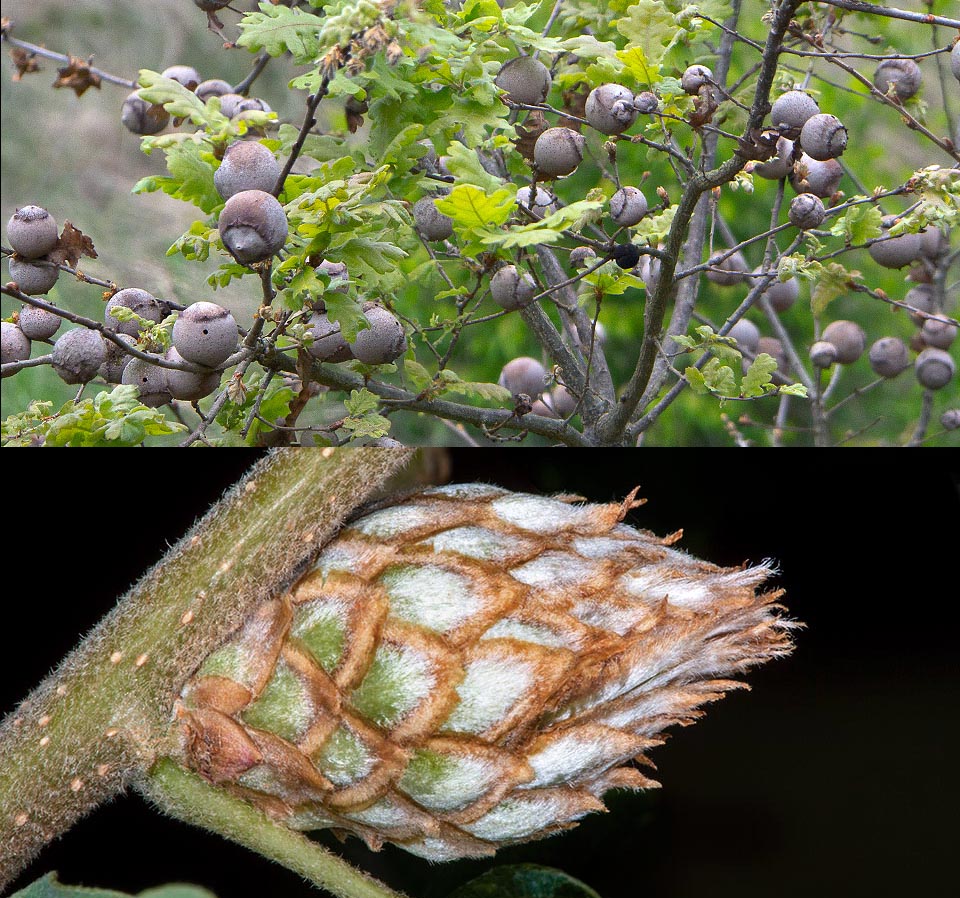
Several are the insects that can cause serious damage to oaks. The damages caused by Cynipids are not significant but determine the development of even curious galls. Above, galls caused by Andricus quercustozae with visible exit holes of adult insects. Below, conversion of a bud in an artichoke-like gall caused by Andricus foecundatrix © Giuseppe Mazza
Throughhout the duration of the Pleistocene glaciations the Mediterranean oaks have often shared the same refugia remaining there even if often in ecologically different sites from each other. In this way, also within individual populations, swarms of hybrid forms with a high morphological and ecological variability have established themselves; then, however, the millennia of deforestations that have burdened these territories have caused the fragmentation of these populations that in several instances isolated themselves from each other and further differentiated themselves for some characters. As global warming progresses, this ample biodiversity today represents an important opportunity, as well as a hope, for the conservation in Europe of the forests of oaks.
In addition to the aforementioned Q. humilis Mill. (1868) and Q. lanuginosa Lam. (1779) and leaving out the divisions in the sub-specific and varietal variants, the synonyms of Quercus pubescens Willd. (1796) are about fifty including Quercus apennina Lam. (1785), Quercus aspera Bosc (1807), Quercus asperata Pers. (1807), Quercus richardii Bosc (1807), Quercus robur var. lanuginosa Ten. (1831), Quercus robur var. virgiliana Ten. (1831), Eriodrys lanata Raf. (1838), Quercus amplifolia Guss. (1845), Quercus cupaniana Guss. (1845), Quercus laciniosa Boreau (1857), Quercus brachyphylla Kotschy (1859), Quercus cerrioides Willk. & Costa (1859), Quercus brevifolia Kotschy ex A.DC. (1864), Quercus macrostipulata Guss. ex Parl. (1868), Quercus subpyrenaica Villar (1935).
→ To appreciate the biodiversity within the FAGACEAE family please click here.
